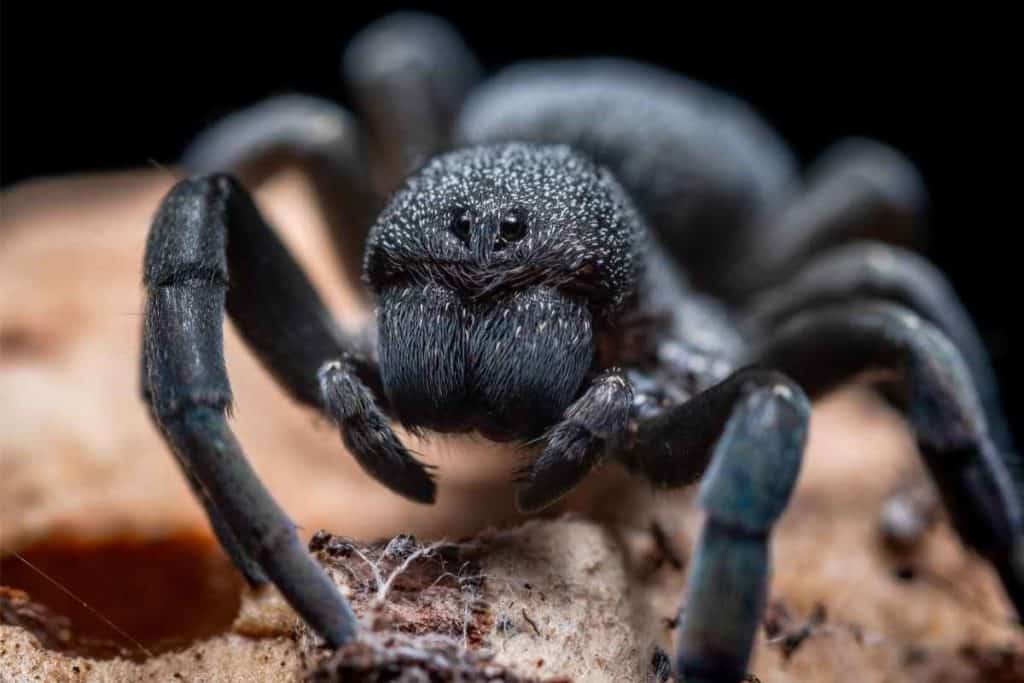Tarantulas are famous for being one of the largest spiders in the world. They are also notorious for terrifying people due to their hairy bodies, fast movement, and perceived aggressive temperament.
Despite their reputation, tarantulas are not dangerous to humans. Although they possess venom, it is a myth that this is deadly. A bite may cause pain similar to a bee sting. (Source)
Therefore, tarantulas have become one of the most popular exotic pets among arachnid enthusiasts worldwide. Whether you have a fear of tarantulas or are a fan of these furry friends, you might wonder, is there a tarantula in Thailand? Well, you’ve come to the right place.
There are four species of tarantula commonly found in Thailand – Cobalt Blue Tarantula, Thailand Zebra Leg Tarantula, Asian Fawn Tarantula, and the Thailand Black Tarantula. However, researchers have recently discovered two new species of tarantula in Thailand (the Dwarf Tarantula and Bamboo Culm Tarantula), which brings the total up to six.
With its distinctive name and all-black look, the Thailand Black Tarantula is arguably the most talked-about tarantula species in Thailand. In this article, we delve deeper into this intriguing creature.
Keep reading to learn everything there is to know about the Thailand Black Tarantula – such as where to find them, their size and temperament, safety advice, and what to do if you encounter one.
Does Thailand Have Tarantulas?
Did you know? The name tarantula is derived from Taranto, Italy, and was originally given to the wolf spider “Lycosa tarentula” in Southern Europe. (Source)
Tarantulas are typically ground-dwellers that thrive in warm temperatures (24°C – 27°C) and open areas of desert and forest ground. So, they are most commonly found in tropical and subtropical regions, such as Central and South America, Australia, Southern Asia, and Africa. (Source)
With dry and well-drained soils and a favorable climate, Thailand provides an ideal habitat for tarantulas and their ‘burrowing’ way of life. Yet, while there are more than 900 different species of tarantulas on earth, it is widely considered that there are only four types of tarantula found in Thailand.
These being:
| # | Species | Official | Thai |
| 1 | Thailand Zebra Leg Tarantula | Haplopelma albostriatum | บึ้งลาย หรือ บึ้งม้าลาย |
| 2 | Cobalt Blue Tarantula | Haplopelma lividum | บึ้งน้ำเงิน |
| 3 | Asian Fawn Tarantula | Chilobrachys huahini | บึ้งน้ำตาล |
| 4 | Thailand Black Tarantula | Haplopelma minax or Cyriopagopus minax | บึ้งดำ |
That was until recently.
In 2017, researchers in Thailand reported a new species of Southeast Asian Dwarf Tarantula in Thailand (a new record of the tarantula genus Phlogiellus Pocock, 1897) (Source)
Whatsmore, in 2022, it was officially announced that JoCho Sippawat, a famous wildlife Youtuber in Thailand, discovered a new genus of the Bamboo Culm Tarantula inhabiting the hollow stems of bamboo plants. This species has been named “Taksinus bambus” in honor of the Thai king Taksin the Great, while Bambus is a reference to bamboo stalks. (Source)

Meaning, that the total number of tarantula species found in Thailand is now considered six.
New World vs. Old World Tarantulas
All tarantulas that live in Thailand are old-world tarantulas.
Old world tarantulas come from the eastern hemisphere, such as Asia, Europe, and Africa (i.e., the “old world”). Old world tarantulas (particularly ones native to Asia) have developed differently from the “new world tarantulas” found in the western hemisphere, such as North, South, and Central America.
They all belong to the Theraphosidae family of spiders. However, new world tarantulas have stockier bodies with more urticating hairs (bristles from their abdomens) that they flick at a threat to defend themselves. They are more docile and slower moving. Whereas old-world tarantulas tend to be more temperamental, move fast, and have a propensity to bite in self-defense. (Source)
Things to Know about Thailand Black Tarantulas

Thailand Black Tarantulas, also known as the “Bird Eating Spider” or “Earth Tiger,” is one of only a handful of tarantulas found in Thailand.
As its name suggests, a distinctive feature is the almost uniform black color without any marks. This species is distributed according to its common name in the center of Southeast Asia.
Taxonomy
| Common Names | Thailand Black Tarantula, Black Thai Tarantula, Thai Black Tarantula |
| Thai Name | แมงมุมทารันทูล่าสีดำ, ทารันทูล่าดำ, บึ้งดำ |
| Scientific Name (Described By) | Cyriopagopus minax (Thorell, 1897) |
| Genus | Cyriopagopus |
| Diet | Carnivores |
| Life Span | In the wild: 10 – 12 years (females 11 – 12 years, males 2 – 4 years) As pets: up to 30 years |
| Size | 15 centimeters in diameter (including legs and body) |
| Weight | 42 grams |
Where to Find the Thai Black Tarantula in Thailand?
Thailand Black Tarantulas are common in the forests of Southeast Asia (Malaysia, Laos, Vietnam, and Thailand). Most of them are distributed in southern Myanmar and southern and eastern Thailand (near the coast of the Andaman Sea).
Khao Sok National Park is a place where Thailand Black Tarantulas are known to live in large numbers.
All tarantulas, including black tarantulas, build burrows in the soil or old tree bark using their silk. By weaving their silk into tubes through the burrows, helps alert them when their prey gets closer. Therefore, once you have made it to the forest, you’ll likely find them living in underground burrows. (Source)
How Long Do Thailand Black Tarantulas Live For?
The life cycle of the Thailand Black Tarantula is pretty much the same as any other spider and involves several phases.
In the wild, the lifespan of a female Thailand Black Tarantula is around 10 – 12 years. Males are much shorter, with a life expectancy of 2 – 3 years, as they die after reaching sexual maturity. Tarantulas as pets can live longer. Males can live up to 10 years, and females up to 30 years.
How Big Is the Thailand Black Tarantula?
The size and color of tarantulas can vary significantly depending on the species and location. Generally, they can range from 11.4 to 28 centimeters in length and weigh from 28.3 to 85 grams. (Source)
The Thailand Black Tarantula is a medium-sized species of tarantula. It can measure up to 15 centimeters in diameter, with a maximum leg span of 13 centimeters and a body span of 7 centimeters. They can weigh approximately 42 grams. As with many other spiders, females are slightly bigger than their male counterparts.
Whatsmore, all tarantulas go through a process called “molting” – essentially, they crawl out of their own skeleton by popping up the top of their head and pulling their body out. During this process, they also replace internal organs.
All tarantulas can grow bigger as they form a new exoskeleton and shed their previous smaller structure. They molt six times in the first year after hatching, then periodically once a year thereafter.
What Do Thailand Black Tarantulas’ Eat?
In the wild, Thailand Black Tarantulas live in areas with abundant food sources. So they do not have to hunt. They are opportunistic carnivores, staying motionless outside their burrow at night, waiting for suspecting prey to pass by.
Despite popular belief, tarantulas do not use a web to trap prey. However, they cleverly leave a thin line of spider silk to signal an alert when something approaches its burrow. Think of a tarantula’s version of a tripwire. (Source)
Whatsmore, they cannot see their prey approaching as they do not have good eyesight. But they can sense it through vibrations with their sensilla (sensory hair). The vibrations get stronger when their prey gets closer, and they are prepared for attack.
The diet of a Thailand Black Tarantula is usually insects, such as crickets, roaches, and mealworms. However, tarantulas can eat bigger animals than insects, such as frogs, toads, lizards, rats, and small birds. After a big meal, they do not need to eat for a month.
Can You Keep a Thailand Black Tarantula as a Pet?
Tarantulas are one of the most popular exotic pets. However, most arachnid enthusiasts keep more docile and friendlier ‘new world’ tarantulas as pets.
With Thailand Black Tarantulas being ‘old-world’ spiders, they tend to be more dangerous due to their aggressive behavior and temperament. Therefore, it is recommended that only experts and experienced keepers have them as pets. Caring for them can be pretty complicated. However, you may find them for sale in pet stores.
Their price depends on their age (adults are more expensive) and gender (males are cheaper due to their short lifespan). Typically, they are not very expensive because they are not in very high demand. As a rough guide, you should expect to pay 50-100 USD (1500-3000 THB) for one specimen.
For example, you can purchase a Thailand Black Tarantula online for under $100 USD (3,000 THB).
Are Thailand Black Tarantula’s Aggressive?
Like most tarantulas, Thailand Black Tarantulas’ are generally not terribly aggressive. They prefer to hide, intimidate, and flee from predators or people than confront them.
Therefore, they isolate themselves for most of their existence – usually hiding in underground burrows or logs. However, they can inflict harm due to their high level of willingness to take the defensive.
In the event that they encounter a predator, they will first pose with a threatening gesture.
Thailand Black Tarantula threat posture is standing up, lifting their pedipalps and the first pair of legs, and spreading the chelicerae, to prepare for self-defense.
If the provocation continues, without fleeing, they will attack a few times and finally bite. When they bite, it is quite dangerous to their prey because their fangs contain venom.
Whatsmore, all tarantulas can be more aggressive during the mating season, hunting time, or even when they have a ferocious appetite. This is because of their self-preservation instincts. Therefore, the temperament of a Thailand Black Tarantula is not easy to handle during this time. (Source) (Source)
Is the Thailand Black Tarantula Poisonous?
It is true that all tarantulas, including Thailand Black Tarantulas, are poisonous which can be deadly or have paralyzing effects on insects or even lab rats. However, tarantula toxicity and tarantula-related injury in humans are rare occurrences.
There is a famous myth from 11th century Southern Italy, that “Tarantism,” (a form of hysteric behavior), was caused by a bite of the wolf spider Lycosa tarantula. This popular belief led people to think that tarantulas are dangerous to humans. (Source)
While tarantulas do possess venom, most injuries to humans are related to irritation from the urticating’s hairs on their abdomen. (Source)
What Happens if You Get Bitten by a Tarantula?
The venom of a tarantula is in no way near toxic enough to pose a threat to humans and has no extreme effects.
People who do get bitten by a tarantula tend to suffer from local symptoms similar to a bee sting for several hours. Such as itching, swelling, and mild-severe pain. Sometimes bites can be painless, and symptoms may be delayed for hours or days, depending on the species.
People who are exposed to tarantulas’ hair can lead to irritation to the skin, eyes, and respiratory tract. If you are bitten by a tarantula or exposed to its urticating’s hairs, there will be no long-term damage in most cases.
However, some people can be allergic to tarantula venom. In this case, symptoms that may occur are shortness of breath, swelling of the eyelids, itchiness, skin rash, swelling of the lips and throat, tachycardia heartbeat, low blood pressure, and poor circulation (loss of blood flow to organs).
What Should You Do if You Get Attacked by a Tarantula?
The risks of being bitten by any tarantula or experiencing the irritating contact of its hairs are low. However, to prevent such problems, simply avoid encountering them. If you come into contact with one, always keep your face and important body parts at a distance.
Bites
If Thailand Black Tarantula bites, you should do the following immediately:
- Wash the area of the bite with soap and water to reduce the chance of infection
- Apply a cool compress or an ice cube to induce numbness and reduce swelling for 10 minutes and then off for 10 minutes
- Apply a paste of powder with water to decrease irritation
- Apply a cortisone or Benadryl cream to reduce irritation
- Watch out for signs or symptoms of an infection or allergic reactions
Flicked hairs
If a tarantula flicks thousands of tiny hairs toward you, you may experience more issues than a bite– especially if their hairs enter your respiratory tract or eyes.
In that event, you should do the following immediately:
- Be careful not to inhale any of the urticating’s hairs and not to touch your eyes
- If possible, apply duct tape or use tweezers to remove hair from your skin as many hairs as you can
- Apply a steroid cream to the affected area for several days
- Watch out for signs or symptoms of an infection or allergic reaction
However, suppose you get any allergic reactions or symptoms mentioned above. In that case, you should immediately seek medical attention from a doctor or call an emergency to be advised on proper safety precautions.
You can contact the National Institute for Emergency Medicine by calling the national toll-free general health emergency hotline “1669” from anywhere in Thailand. They will give you further instructions.
Conclusion
Thailand Black Tarantulas are common in Southeast Asia, but it is unlikely that you will come into contact with one during your visit to Thailand. This is because they generally prefer to hide underground.
But if you encounter one and are accidentally attacked, it is not a danger because their venoms are harmless to humans. But if your symptoms involve an allergic reaction, then seek medical help.
Overall, you are better off avoiding them during your trip, and it is not difficult to do so. However, if you are an arachnid enthusiast, then an excellent place to find Thailand Black Tarantulas is in Khao Sok National Park.
Perhaps you can follow in JoCho Sippawat’s footsteps and find the next tarantula species in Thailand!
THINKING ABOUT A TRIP TO THAILAND?
I am working on a FREE Thailand Travel Guide with a FULL 7 Day Itinerary. Be the first to receive it!
Thank you for signing up.
Something went wrong.
